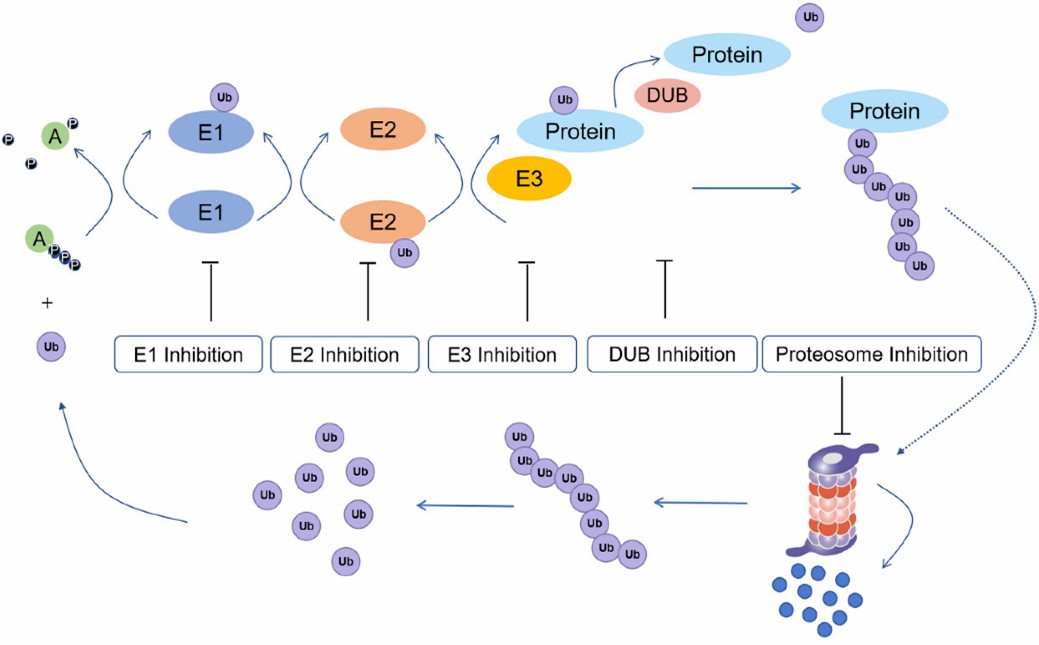Creative Proteomics provides comprehensive protein ubiquitination analysis services to help customers gain a deeper understanding of the regulatory mechanisms of life activities, providing potential directions for exploring new therapeutic strategies as well as drug development. At the same time, we are committed to meeting the requirements of the ICH Q6B guideline on the need to identify the type of modification in biological products.
Why do Protein Ubiquitination Analysis?
A protein is modified post-translationally during the process of protein ubiquitination by the attachment of ubiquitin, a tiny regulatory protein found in all tissues. Three primary steps make up the process: activation, conjugation, and attachment. These steps are carried out, respectively, by the enzymes E1, E2, and E3. Proteins are frequently tagged for breakdown, their cellular position is altered, their activity is influenced, and their ability to interact with other proteins is either facilitated or blocked by ubiquitination. It is crucial for a number of biological processes, including cell cycle regulation, DNA repair, immunological response, and DNA maintenance.
 Fig 1. Ubiquitination process and potential drug inhibition targets (E1: ubiquitin-activating enzyme; E2: ubiquitin conjugating enzyme; E3: ubiquitin protein ligase; Protein: substrate/target protein; DUB: deubiquitinating enzyme). (Ying, Qi. S., et al.; 2021)
Fig 1. Ubiquitination process and potential drug inhibition targets (E1: ubiquitin-activating enzyme; E2: ubiquitin conjugating enzyme; E3: ubiquitin protein ligase; Protein: substrate/target protein; DUB: deubiquitinating enzyme). (Ying, Qi. S., et al.; 2021)
Challenge in Protein Ubiquitination Analysis
Dynamic Process Monitoring: The ubiquitination state of proteins can change rapidly in response to changes in the cellular environment and environmental cues, making it difficult to capture and analyze in "real time".
Ubiquitin Chain Diversity: Ubiquitin can be linked together in different ways to form a variety of chain structures, each of which may have different biological effects. This diversity of potential structures adds to the complexity of analysis.
Assay Limitations: Traditional methods for studying ubiquitin include immunoblotting or mass spectrometry. Immunoblotting may lack sensitivity and specificity, while mass spectrometry, although a powerful tool, can be technically challenging and may not capture all ubiquitination sites.
Cellular Complexity: Ubiquitination may occur in many different cell types and cell compartments, adding to the complexity of the analysis.
Reversible Nature: Ubiquitination is a reversible process (due to the action of deubiquitinating enzymes), a property that makes it possible to perform steady-state analyses of the ubiquitination state of specific proteins.
What can we offer?

Proteins are separated by gel electrophoresis and then transferred onto a membrane using the Western blotting technique. The membrane is then examined for ubiquitination using particular antibodies directed against ubiquitin or proteins that have been attached to ubiquitin.

This method uses certain antibodies to selectively precipitate a target protein and the ubiquitin molecules that are linked to it. The ubiquitinated proteins in the precipitate are then identified and measured using methods like mass spectrometry and Western blotting.

Utilizing the high-resolution method of mass spectrometry, ubiquitinated proteins are identified and quantified by examining their mass-to-charge ratios. The location and kind of ubiquitination that has taken place on a given protein can be determined using mass spectrometry.
- Ubiquitin binding domain assays

Ubiquitin binding domains (UBDs) are protein domains that recognize ubiquitin or ubiquitin-conjugated proteins with a particular specificity. In UBD assays, ubiquitin or a particular UBD protein is fluorescently tagged and used to search complicated samples for ubiquitinated proteins.
- Ubiquitin chain restriction analysis

Utilizing particular enzymes or antibodies to selectively cleave or detect various ubiquitin links is the process known as ubiquitin chain restriction analysis. The kind and degree of protein ubiquitination can be identified by examining the sizes and distributions of ubiquitin chains.
Service Process

Our Commitment and Future Goals
Creative Proteomics provides protein drug characterization services covering all aspects of protein characterization, including structural analysis, post-translational modification analysis, impurity analysis and stability studies. Our services provide not only high quality results, but also an exceptional service experience. If you are interested in our services, please contact us for more details.
Reference
- Ying, Qi. S., et al.; Ubiquitination Regulators Discovered by Virtual Screening for the Treatment of Cancer. Frontiers in Cell and Developmental Biology. 2021, 9:665646
Related Sections
Services
Applications
For research use only, not intended for any clinical use.


 Fig 1. Ubiquitination process and potential drug inhibition targets (E1: ubiquitin-activating enzyme; E2: ubiquitin conjugating enzyme; E3: ubiquitin protein ligase; Protein: substrate/target protein; DUB: deubiquitinating enzyme). (Ying, Qi. S., et al.; 2021)
Fig 1. Ubiquitination process and potential drug inhibition targets (E1: ubiquitin-activating enzyme; E2: ubiquitin conjugating enzyme; E3: ubiquitin protein ligase; Protein: substrate/target protein; DUB: deubiquitinating enzyme). (Ying, Qi. S., et al.; 2021)





